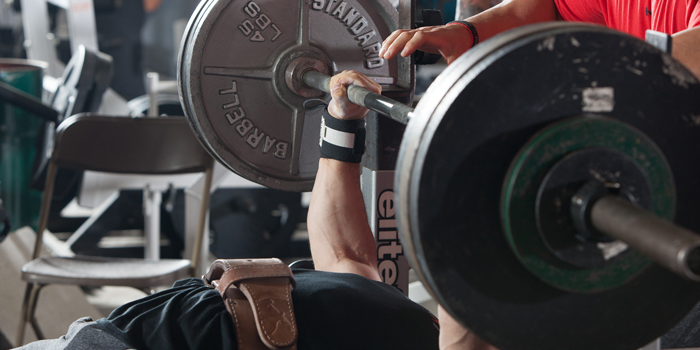
When it comes to fixing a lift, the idea that one size fits all and talking in absolutes is just silly. I see all over the internet overly sensationalized statements to ruffle feathers without any context. Trust me when I say you are not a trailblazer; you are just silly. Anyone who has ever coached before knows that context is king. So, absolute statements should never be made. In this article, I will break down the bench press and look at some ways to improve it. This will mostly apply to strength athletes looking to improve their bench press and not bodybuilders looking to grow a bigger chest. The barbell bench press may be the last exercise I would prescribe for a bodybuilder to grow their chest. As I said, context is king.
RECENT: 3 Questions to Answer Before Your Next Diet
Training Frequency
Before getting into the lift and breaking down sticking points, let's examine training frequency of the bench press. It is a lift that doesn’t produce as much fatigue as the squat or the deadlift, mainly due to the load being lifted is far less; therefore, we can train it more frequently. Does more always mean better? In this meta-analysis by Grgic and colleagues, they found that a higher frequency resulted in greater gains in muscular strength on multi-joint exercises in the upper body. With the frequency increasing one- to four-plus times a week, the effect size increased right along with it. It seems like the more often you can bench, the greater the results as long as you can recover from the training. The stronger you become, the less frequency and volume you can handle and still recover. I would recommend beginners benching three to four times a week and intermediates to advanced two times per week. Some of the strongest bench pressers in the world may only bench once every 10-14 days to give some more context. When it comes to volume, things get a little bit more complicated depending on how you set up your training, which goes beyond the scope of this article. The volume I would recommend is between eight to twenty sets per week, depending on your strength levels, recovery abilities, and how close you train to failure. Keep in mind these volume recommendations include shoulders, triceps, and chest, not just bench press.
Bench Press Setup
When you start to analyze your bench press and realize where you're weak, you must perfect your setup. Without a perfect setup, it would be hard to identify what the real issue is. In this video, I go over how I like to set up for the bench press.
There are a bunch of different ways to set up that will be extremely effective, this is just my way of explaining the intent of the setup. The key here is to set up the same way each and every time so you can build consistency within the lift and that way you can start to qualify each rep and build upon it.
Sticking Point Breakdown
Now that we have things somewhat standardized, we can start to break down where you miss the lift. Keep in mind though, if your technique is not dialed in and consistent then this other stuff won’t matter as much.
Off the Chest
If you miss the bench just off of your chest, you are either losing tightness with your back and core, or you have a weak chest. One can be fixed with more technique work and the other can be fixed with exercise selection.
To target your chest and build it up, you want to think about challenging the muscle as much as possible. This can be done with a wide grip bent bar bench variation, DB press work (flat, incline, decline), fly’s, or chest press machines. The biggest thing with these is to make sure you are set up to challenge the pec and not just move weight. We have to disconnect with the idea of moving weight when it comes to growing a muscle.
Midway Up
If you get stuck about midway up you're either pressing in a straight line when you should be pressing more towards your face, you are letting the bar sink too much, or you need more pec and triceps work but within that specific range.
A great exercise for this issue is a close grip floor press or a close grip Spoto bench press. Weighted dips are also great for building up this weak area. The Spotos are preferred if you have an issue with letting the bar sink too much. If you are missing at lockout, it is usually a combination of weak triceps and shoulders. Overhead work and high incline press work is a great way to build that area up. I am not a huge fan of pushing heavy weight on triceps isolation work. This usually leads to elbow pain and tendinopathy issues that will become debilitating to keep pressing. It also doesn’t do much in terms of building a strong bench. Any iso triceps work should be done in a higher rep range to keep stress off the elbows so you can keep pressing pain-free. I like to work on muscular weaknesses in a multiple set of rep ranges and try to get as strong as possible in those ranges. For barbell movements, I stick to the four to eight rep range. For dumbbell work, I like the six to twelve rep range, and for any isolation work, I like the 12-20 rep range. Regardless of rep range, we want to prioritize the execution of the movement first and foremost. Secondly, we want to progressively overload them in some manner each time we have those same movements.
I hope this gives you an idea of what is going on when you are looking to improve your bench press. Sometimes it takes a little outside-the-box thinking. Find the proper frequency and volume you can recover from is first. Secondly, you want to systematize your setup and perfect it. Lastly, you want to break down why you are missing the lift and then work on those weaknesses through exercise selection.
References
- Grgic, J., Schoenfeld, B. J., Davies, T. B., Lazinica, B., Krieger, J. W., & Pedisic, Z. (2018). Effect of resistance training frequency on gains in muscular strength: A systematic review and meta-analysis. Sports Medicine, 48(5), 1207-1220. https://doi.org/10.1007/s40279-018-0872-x











2 Comments